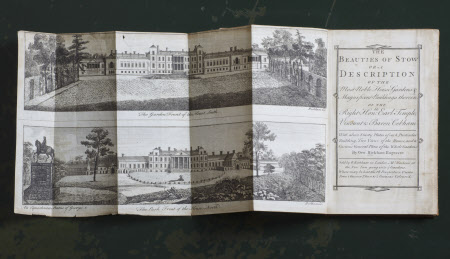The beauties of Stow; : or a description of the most noble house, gardens & magnificent buildings therein, of the Right Hon[oura]ble Earl Temple, Viscount & Baron Cobham ... / by Geo. Bickham ...
George Bickham the younger (c.1706-1771)
Category
Books
Date
1753
Materials
Place of origin
London
Order this imageCollection
Anglesey Abbey, Cambridgeshire
NT 3124422
Summary
George Bickham, The Beauties of Stow; or a Description of the Most Noble House, Gardens & Magnificent Buildings therein, of the Right Honble Earl Temple, London: sold by G. Bickham in London, M. Hoskins at the New Inn, [1753]. Binding: Eighteenth-century full calf over boards; gilt fillets to form a border; gilt spine fillets; sewn on five raised bands; upper board detached.
Full description
Lord Cobham’s gardens at Stowe had been attracting visitors since the 1720s, but the first guidebook was issued by the Buckingham writing master Benton Seeley in 1744. The venture was a great success and by 1750 Seely was offering three parallel publications to tourists, his original ‘Description of the Gardens of Lord Viscount Cobham at Stow’ (1744), Giplin’s ‘Dialogue on the Gardens at Stow’ (1748), and ‘Views of the Temples and other Ornamental Buildings in the Gardens’ (1750). These could be bought separately for 2s 6d each, or all three bound together, with an added title-page, at 5s. Together, they provided the well-heeled visitor with a practical description, an aesthetic critique and an illustrated souvenir. At this point competition came on the scene in the form of two London booksellers and publishers, the George Bickhams, father and son. Like Seely, the elder George Bickham (1684?-1758?) was a writing master, but George Bickham Junior (1706?-1777) rather grandly described himself as ‘drawing master to the Academy at Greenwich.’ The Bickhams had already made a name for themselves by issuing a wide variety of writing and dancing manuals, as well as a guidebook to Hampton Court and Windsor (1742), and George Bickham Junior’s ‘General Rules for Painting in Oil and Water-Colours’ (1747). Stowe was clearly too enticing – and lucrative – an opportunity to miss. In 1749 Seely’s patron Viscount Cobham had died, and in 1750 the Bickhams issued their own guidebook, ‘The Beauties of Stow’, an octavo of 64 pages, with plates by George Bickham Junior, priced at 5s. It contained all the material offered by Seeley in his compendium, but with more attractive illustrations and a better-organised text, set out in the form of a guided tour of the garden. But at least 98 per cent of this text was simply lifted from existing publications, roughly a third each from Seely’s ‘Description’ and Gilpin’s ‘Dialogue’, with further material; derived from the French language guide ‘Les Charmes de Stow’ (1748) and from Defoe’s ‘Tour thro’ the Whole Island of Great Britain’ (1724-6). Unsurprisingly Benton Seeley was unhappy at this unexpected competition and there followed a protracted and acrimonious tussle, as he and the Bickhams competed to produce ever more refined and appealing guidebooks, adding at various times further illustrations, new text, and a ‘Curious General Plan of the Whole Gardens.’ Seeley cannot have been happy to discover Bickham’s guides on sale ‘at the New Inn, going into ye Gardens’. But Bickham only made his contempt for local competition abundantly clear by replacing the Cobham epitaph in his plate of the Egyptian pyramid with a carefully blurred ‘SEELEY IS A****’. Finally, in 1763, Bickham retired from the fray, leaving the field open to the Seeley family, who continued to issue Stowe guidebooks well into the nineteenth century. But the battle of the guidebooks at Stowe marked a turning point in the development of tourist literature in eighteenth-century England, and it is not difficult to see why Lord Fairhaven – the creator of one of the great landscape gardens of the twentieth century – might have been attracted to one of Bickham’s latest and most refined guides. Text adapted from Mark Purcell's entry in ‘Treasures from Lord Fairhaven’s Library at Anglesey Abbey’, National Trust, 2013, cat. 10, pp. 62-3.
Bibliographic description
[2], 40, [2] p., [32] leaves of plates (2 folding) : ill., map ; 8vo. Plates not coloured. Loosely inserted: clipping from bookseller’s catalogue, apparently describing this copy, with price £12/12/-. Pencil price "£12/12/" on verso of front free endpaper. Provenance: Eighteenth-century inscription on flyleaf: G. S. Seidli [?]. Pencil note: Bickham. Binding: Eighteenth-century full calf over boards; gilt fillets to form a border; gilt spine fillets; sewn on five raised bands; upper board detached.
Provenance
Purchased by Huttleston Rogers Broughton, 1st Lord Fairhaven (1896-1966) from an anonymous bookseller for £12 12s and then bequeathed by him to the National Trust with the house and the rest of the contents in 1966.
Makers and roles
George Bickham the younger (c.1706-1771)
References
Mark Purcell, William Hale and David Person, Treasures from Lord Fairhaven’s Library at Anglesey Abbey, Swindon: National Trust; London: Scala Arts & Heritage Publishers, 2013., pp. 62-3
